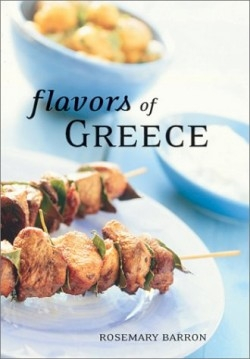Flavors of Greece
Like the azure waters of the Aegean, this cookbook invites readers to dive in. When they do they’ll find refreshment and restoration. The author revitalizes readers with whole-hearted
passion and unceasing hospitality through the Greek diet of olives, wheat, figs, fish, and abundant produce.
Barron first introduces readers to a little of the culture and history of Greece. Until 3500
B.C. its inhabitants grilled and baked the food they hunted, fished, or gathered. Barron says, “But with the advent of what has been called the ‘Greek miracle’ - the budding of the sophisticated Minoan civilization on the islands of Crete and Santorini - Greek cuisine began to develop a strongly individual style.” Trade links brought dates, olives, onions, and many other foods to this “Garden of Eden.”
As they turn the pages, readers will feel the Mediterranean sun warming their backs and catch a glimpse of the sparkle of sky and sea. They might even imagine the intoxicating
aroma of lemon blossoms mixed with wild oregano as Barron launches into a detailed description of a Greek kitchen. She offers recipes for preserved lemons, yogurt, and candied citrus zest, and details varieties of Greek olives, cheese, and herbs.
The luxuriant offerings begin with chapters on appetizers; soups; light meals of egg, stuffed
vegetables, and savory pies; fish and seafood and chicken and game. Recipes for meats; vegetables and salads; rice and pasta; breads; pies, pastries, cakes, and cookies; fruit desserts and sweets follow.
This cookbook takes a comprehensive look at Greek food and its history, and no one is better
qualified than Barron to write it. A seasoned cook and teaching veteran, Barron first became fascinated with Greek food and its history during an archaeological dig on Crete. Fifteen years later she opened a cooking school on Santorini and Crete. She operated it for six years, weaving Greek foods and wines into the daily culture and rhythms of Greek village life for her American and Canadian students. Barron continues to lecture, write, and teach about
Greek food and its culinary culture, ancient and modern, around the world.
Greek food is one of the three ancient Mother cuisines (along with Italian and Chinese). Barron
tells readers that a Greek invented the fork and that Greeks established the first culinary schools. She says, “Ancient Greeks regarded cooking as both an art and a science and throughout the ancient world Greek chefs were accorded the status and reputation that French chefs now enjoy.”
Prosaic Greek salads and souvlakis pass for Greek food in America. Barron’s recipes-laced
with quince paste, dates, honey, and marjoram-read like poetry. Peppered Dried
Figs, Black Olives and Lentil Salata, Tiny Vegetable Pies, Avgolemono Soup, Stuffed
Onions with Green Grape Sauce, Sea Bass with Vinegar and Rosemary, Chicken with Walnut and Coriander Sauce, and Cinnamon Lamb with Eggplants are as inviting as they are uncomplicated.
The chapters on Vegetables and Salads and Pilafs and Pastas offer Baked Eggplants with Tomatoes and Feta Cheese, Sweet Sour Okra with Olive Oil, Honey-Glazed Onions, Wild
Greens Salad, Eggplant Pilaf with Glazed Tomatoes, Spiced Shrimp Pilaf, and Kritharaki (orzo pasta) with Brown Butter and Cheese. The Breads and Sweets chapter is generous, with recipes for handmade phyllo and many phyllo desserts, Sticky Yogurt Cake, Fragrant Apricot Ice Cream, and Sweet Baked Figs.
Cooks won’t need a degree in French to understand these dishes- their sense of taste and Barron’s guidance will be enough. The author writes clear, crisp recipes with flavor-enhancing tips. For example, in the recipe for Stuffed Grape Leaves with Latholemono Sauce, she suggests achieving a rich, velvety finish by
substituting Green Grape Sauce for half the water, as the Cretans do, to cook the stuffed grape leaves.
Everywhere readers look in this fine cookbook they will meet some new and enticing bit of food
information. Barron devotes several pages to Greek wines and spirits, naming producers and the grapes they grow. In her detailed glossary she informs the readers about anchovies, cephalopods, khorta (wild greens), kid (how to buy, prepare, and roast this older lamb over coals), onion juice (Greeks use it to tenderize and flavor meat before grilling), and sea urchins and snails (how to gather, feed, cook, and prepare them).
Barron offers readers a path to vibrant, exciting food through this bursting-at-the-seams
cookbook. They may not have the Aegean at their doorstep, nor the sweet fragrance of lemons drifting through on a salty breeze, but with Barron’s cookbook their kitchen will carry the essence of Greece all the same.
Disclosure: This article is not an endorsement, but a review. The publisher of this book provided free copies of the book to have their book reviewed by a professional reviewer. No fee was paid by the publisher for this review. Foreword Reviews only recommends books that we love. Foreword Magazine, Inc. is disclosing this in accordance with the Federal Trade Commission’s 16 CFR, Part 255.

